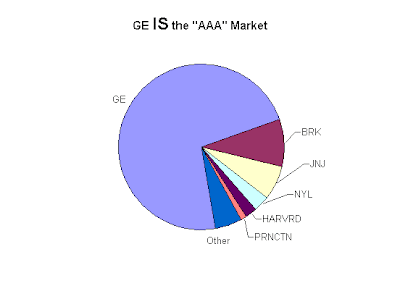The big question surrounding the toxic asset plan is will banks sell? I've put a little pencil to paper here and come up with some actual numbers.
First of all, I expect the Legacy Securities Program will work wonderfully. Sellers will flock to it like Jawas to a stray astromech droid. This program is aimed at securities which have been severely impaired from both a credit and liquidity perspective. CLOs, RMBS, ABS, CMBS, etc. The program should succeed in turning these programs into just credit impaired. In effect, it will separate the red ones with the bad motivators from the blue ones in prime condition. That will be key to an eventual economic recovery. It should foster a healthy new issue market for RMBS, ABS and CMBS (don't know that CLOs can come back), which will help get the velocity of money back to a more normal level.
Obviously having ready buyers able to earn impressive ROEs should improve the value of the underlying assets. Financial institutions have already marked these securities to market, an improvement in the actual value of the instruments ought to result in an improvement of balance sheets. This will particularly benefit financials who invested primarily at the top of the asset-backed capital structure. It will also benefit those that hold more risk in securities (such as brokerages Goldman Sachs and Morgan Stanley and possibly some P&C insurers) and less those that hold risk in loans (such as almost all banks). Even there, much of Goldman and Morgan's risks are tied to the equity markets, not to debt markets. Same goes for life insurance, generally speaking.
That brings us to the with the Treasury's Legacy Loan Program. I expect this to go over like the exotic twi'lek dancer's routine in Jabba's palace. The plan will indeed increase the theoretical price at which banks could sell loans. That's fine, but its short help. Loans haven't been marked to market. Instead, they are held at book value less an allowance for expected loss.
I've done some deep dives on bank residential loan portfolios. Getting detailed data is a challenge, but basically I tried to figure out what percentage of the bank's current portfolio is "challenged." High CLTV, bad geographics, low FICO, etc. You can make a relatively safe assumption that most of the loss reserve is pledged to those kinds of loans. Anyway, I can't find any big banks that are holding, say home equity loans at less than 90% of face. Unless the Legacy Loan Program winds up buying assets at $90 or more, banks won't sell.
So will the PPIF's pay $90? I doubt it. Take home equity loans as an example. Start with the following assumptions:
- PPIFs get loans at 1mo-LIBOR +50bps. Its hard to say exactly what the cost of funds might be, but worth noting that FDIC paper trades around L+20.
- 6-1 leverage, which is the max allowed under the program. I think its reasonable that non-delinquent, prime loans would get the max leverage.
- Assume the loans float at Prime-flat.
- Assume the loans are 1-2 years old, and will repay over the course of 6 years. To make it easy I'm going to assume equal payments per month.
- The pool of loans will suffer 10% cumulative losses, all of which occur in the first two years. I won't write down the losses as they occur, simply take away the interest. That's consistent with a hold-to-maturity IRR calculation.
- Finally, and perhaps most importantly, I'm assuming that the PPIF equity investors are targeting an IRR of 20%.
That price will render it impossible for most banks to sell. For example, based on Bank of America's recent earnings presentation, it has something like $250 billion of prime, non-delinquent home equity loans with 90%+ LTV. I'd call this the kind of stuff that isn't exactly toxic, but selling could improve BAC's risk exposure significantly. Say they effectively have a $90 mark on these. If they sell at $82, they'd suffer an 8% loss versus their capital, or $20 billion. BAC has core equity capital of $48 billion. You do the math.
I don't expect commercial loans to be much better. Now a lot of commercial stuff has large loan loss reserves, and therefore sales would more easily be accretive to capital. But commercial loans are also present an information asymmetry problem. You can put a zillion residential loans into a pool and get some semblance of diversification. You can then look at average stats and get some idea of the make-up of the loans: geo diversification, average FICO, etc. A bank that is selling a commercial loan is telling you they don't want that commercial loan anymore.
This isn't to say the toxic asset plan will have no positive impact, but it is likely to be more indirect than investors are currently hoping. The best chance banks have for decreasing their residential loan portfolios is a revived securitization market, which is the primary aim of the TALF. Banks may be more willing to sell a portion of their home equity loans as a senior security, with the bank retaining a subordinate position. In that case, the bank might retain the upside while still freeing up some capital. In addition, a revived securitization market would give the market confidence that banks have enough liquidity to hold their loan portfolios to maturity.
It will also help banks who have made larger writedowns, especially those that made acquisitions. At the time of acquisition, the bank has to write down the loan to fair market value. In the case of J.P. Morgan's acquisition of WaMu, or Wells Fargo's acquisition of Wachovia, there would be no motivation to under-estimate the FMV decline. Those banks could therefore enjoy improved capital positions from certain sales.



